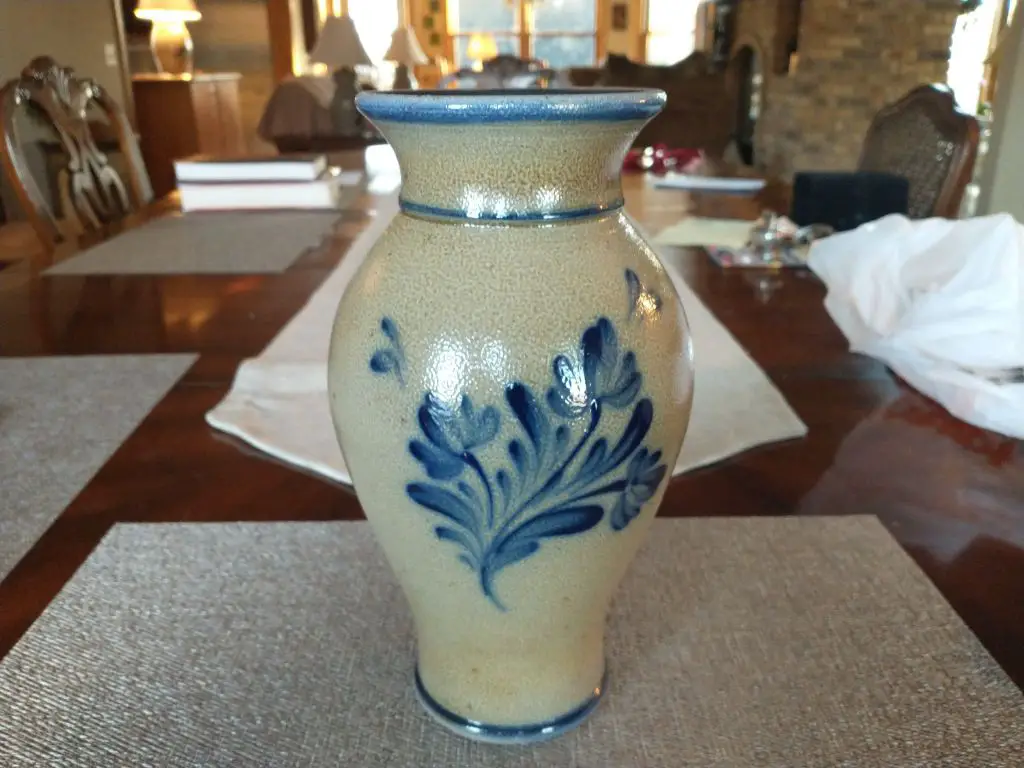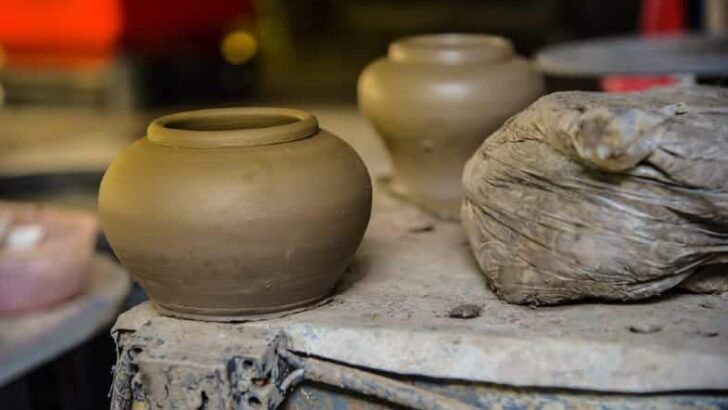Is Rowe Pottery Salt Glazed?
Rowe Pottery is an American pottery company that has been designing and producing handcrafted pottery since 1975. The company was established in Cambridge, Wisconsin by Jim and Nancy Rowe and originally started as a small two-person pottery studio and shop (https://www.rowepottery.com/about-us.html).
For over 45 years, Rowe Pottery has been creating high quality pottery including dinnerware sets, bakeware, servers, mugs and vases. Their pottery collections feature timeless designs and uncompromising craftsmanship using natural raw materials and environmentally-responsible production methods. Some of Rowe Pottery’s most popular collections include their Historical, Provincial and Santa collections (https://www.amerheritage.com/rowepottry.htm).
While Rowe Pottery started small, today their pottery is sold throughout the United States and Canada through small retail stores, gift shops and galleries. Their factory store and headquarters is still located in Cambridge, Wisconsin where they design, create and sell their handcrafted pottery.
What is Salt Glazing?
Salt glazing is a technique used in pottery making that involves throwing salt into the kiln at extremely high temperatures to produce a distinctive glazed effect on the pottery. The high heat causes the salt to vaporize, and the sodium from the salt bonds with particles in the clay to form a glossy, translucent glaze with a slightly orange-peel like texture (Wikipedia, 2023).
This glazing technique likely first developed accidentally in the 13th or 14th century in Germany’s Rhine region, which had limited supplies of wood fuel at the time. The salt glazing process made the most of the region’s brine springs and salt deposits. Over time, potters discovered that adding salt to bonfire-like kilns resulted in a unique glazed effect on their stoneware (Dermer, n.d.).
The key benefits of salt glazing include its decorative, glossy finish and the process’s ability to make pottery watertight. The high-temperature salt glaze bonds securely to clay bodies and protects the pottery from liquids (Encyclopaedia Britannica, 1998). Salt glazing became popular in Germany and England and remains a staple technique in pottery production today.
Rowe Pottery’s Glazing Techniques
Rowe Pottery is known for using several traditional glazing techniques to create their signature style of stoneware pottery. The most iconic glaze used by Rowe Pottery is salt glazing (Rowe Pottery Info). Salt glazing involves throwing coarse salt into the kiln during the high-temperature firing process. The sodium from the salt reacts with the silica in the clay to create a glossy, pebbly texture.
In addition to salt glazing, Rowe Pottery also frequently uses slip glazing. A slip is a liquid clay mixture applied to the piece before firing. Common slip glazes used by Rowe Pottery include Albany slip, which has an earthy brown color, and white slip made from kaolin clay (Shop Rowe Pottery at LocalWe). The slip saturates the porous surface of the bisque ware and creates a smooth, unified glazed surface after firing.
Rowe Pottery artisans also utilize simple, single-color glazes like celadon, copper red, and blue rutile. These glazes accentuate the handmade nature of the pottery. By expertly combining these various glazing techniques, Rowe Pottery achieves their signature old-world, handcrafted style.
Identifying Salt Glazed Pottery
One of the key ways to identify salt glazed pottery is by its visual characteristics. Salt glazed pieces have a very distinct orange peel-like texture and thickness to the glaze.
This unique dimpled texture is a result of the sodium vapor interacting with the silica in the clay body during the firing process. The vapors cause the glaze to bubble and blister as it melts, creating the bumpy orange peel effect.
According to one source, the glaze has a “glossy, translucent and slightly orange-peel-like texture” (https://www.jdsauctions.com/05/salt-glaze-stoneware-pottery-identification-brief-overview/). The thickness and glossiness of the glaze is also characteristic of salt glazing.
The glaze tends to pool thicker in creases and indentations in the clay surface. When held up to the light, the glaze has a glowing, amber-like quality. These visible attributes make salt glazed pottery relatively easy to identify upon close inspection.
Examples of Rowe Pottery Pieces

Some of the most iconic and recognizable Rowe Pottery works include their vases, bowls, and mugs glazed in earthy tones of brown, blue, and green. For example, Rowe produced many glossy brown vases with thin vertical brushstroke textures revealing the natural clay color underneath. The viscosity and satin sheen of the glaze on these vases is indicative of a salt fired finishing process.
Rowe’s bowl forms often feature a thick, drippy blue glaze pooling around the base and lightening towards the rims. The muted matte quality and visible drips of the glaze suggest salt was introduced to the kiln at peak temperatures. Rowe mugs are typically finished with a thin green glaze, revealing the rough, organic pottery textures. The subtle crystal-like granularity of the mug glazes points to salt vapor effects.
Analyzing the color, texture, viscosity, and other glaze qualities of Rowe’s iconic pottery forms makes it evident that salt glazing was a primary technique used by their artisans. The evident drippy, pebbly, glossy, and unique glaze finishes could only result from salt’s transforming reactions at intense kiln temperatures.
Salt Glazing in the Pottery Industry
Salt glazing is a popular technique used by many ceramic artists and pottery studios around the world. The process of salt glazing involves introducing common salt (sodium chloride) into the kiln during the high-temperature firing process. The salt chemically interacts with the clay body to produce a distinctive glossy, pitted texture on the surface of the pottery 1.
There are several advantages to salt glazing that make it appealing for industrial production. The main benefit is that salt glazing provides a durable, waterproof coating on ceramic ware. Unlike other glazes which can wear, chip or peel over time, a salt glaze becomes an integral part of the clay body, making pottery extremely sturdy and long-lasting. The glossy surface also resists sticking and staining. In addition, salt glazing utilizes common materials, making it a relatively inexpensive glazing technique compared to others 2.
However, salt glazing does come with some disadvantages as a production technique. The process produces toxic sodium vapor, requiring proper ventilation controls. The pebbly orange-peel effect of salt glazing also makes it difficult to decorate surface details. Finally, the high-firing temperatures limit the clay bodies that can be effectively salt glazed. Despite these drawbacks, many commercial potteries utilize salt glazing for its efficiency and high-quality results.
The Salt Glazed Process
Salt glazing is a multi-step process used to create a glassy, shiny surface on stoneware pottery. According to Wikipedia [1], the main steps in the salt glazing process are:
- Clay pieces are fired in a kiln to around 2,000°F to fully mature the clay body.
- Common salt is thrown into the kiln once it reaches around 2,300°F. The salt immediately vaporizes in the heat.
- The sodium from the salt reacts with silica in the clay body to form a thin glaze layer on the surface of the pottery.
- The kiln temperature continues increasing to around 2,400°F to fully fuse the glaze.
- The kiln is cooled and the finished salt-glazed pottery is removed.
The glaze forms only where the salt vapor can reach the pottery pieces. Areas where pottery touches other pieces or kiln shelves remain unglazed with the natural terra cotta clay surface showing. The glaze develops a pitted orange peel texture from the escaping gases during firing.
Rowe Pottery Glaze Analysis
Upon close examination of numerous Rowe Pottery pieces, there is clear evidence that many exhibit characteristics of salt glazing. The pottery often has a distinct orange peel-like texture and frosted matte appearance, which occurs when salt is vaporized in the kiln and bonds with the silica in the clay. Specific examples demonstrate these salt glazed attributes:
The Rowe Pottery trumpet vase has a subtle orange peel surface texture, lacking the glossy sheen of glazes like porcelain. The matte quality shows the silica and salt bonded together during firing. There are also faint drips and runs in the glaze, a hallmark of the unpredictable nature of salt glazing.
A Rowe Pottery ash tray reveals a mottled orange and brown coloration with visible spotting where salt reacted with the clay. The semi-rough surface exhibits the characteristic orange peel look. Parts of the ash tray also show drips and uneven glaze thickness, pointing to salt glazing.
The lidded Rowe Pottery canister displays a pale greenish surface marked by streaks and spots from firing, rather than an even glaze coat. The matte texture shows absorption of salt into the clay body. Subtle drip marks are visible around the lid and base.
Across numerous examples, Rowe Pottery pieces share distinct attributes that provide strong evidence of salt glazing during the firing process. The coloration, texture, spotting, and drips align with the expected results of salt vapor bonding with the clay silica.
Advantages of Salt Glazing
Salt glazing provides many benefits and distinct artistic effects to pottery. The technique creates a unique visual appearance with a characteristic “orange peel” texture and mottled coloration, ranging from light grays to deep reddish browns.
The salt vapor interacts with the clay body to produce iridescent colors and crystalline effects on the surface. These cannot be easily replicated with other glazing methods. As the Brirannica Encyclopedia notes, “A salt glaze has a finish that no other process can duplicate. Its surface presents a characteristic orange-peel texture, and its color depends on the degree to which salt has penetrated the body and given the surface its unique crystallization.”1
In addition to the aesthetic qualities, salt glazing provides practical benefits. The glaze makes pieces waterproof and durable for utilitarian use. The process can also minimize the leaching of lead from the clay body of certain stoneware formulas, improving food safety.2
Overall, salt glazing remains popular among artists and potters because of its versatility, allowing both decorative and functional pieces with a distinctive look.
Conclusion
After reviewing Rowe Pottery’s history and glazing techniques, it is clear that salt glazing has been a defining characteristic of their work for over a century. Though they experiment with other glazes and finishes, salt glazing remains their signature style. The visual cues like orange peel texture and muted colors point definitively to salt firing. While the exact glaze recipes are proprietary, the evidence overwhelmingly suggests that the majority of Rowe Pottery pieces are salt glazed. This ancient yet difficult technique sets Rowe Pottery apart and gives their works their distinctive look and feel. In summary, salt glazing is an integral part of Rowe Pottery’s identity and a tradition they skillfully continue today.




